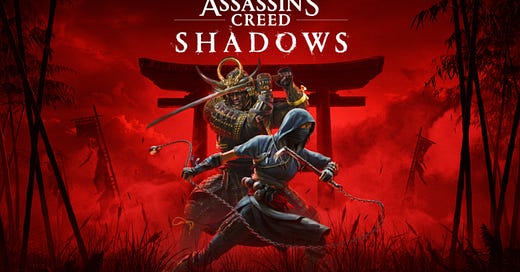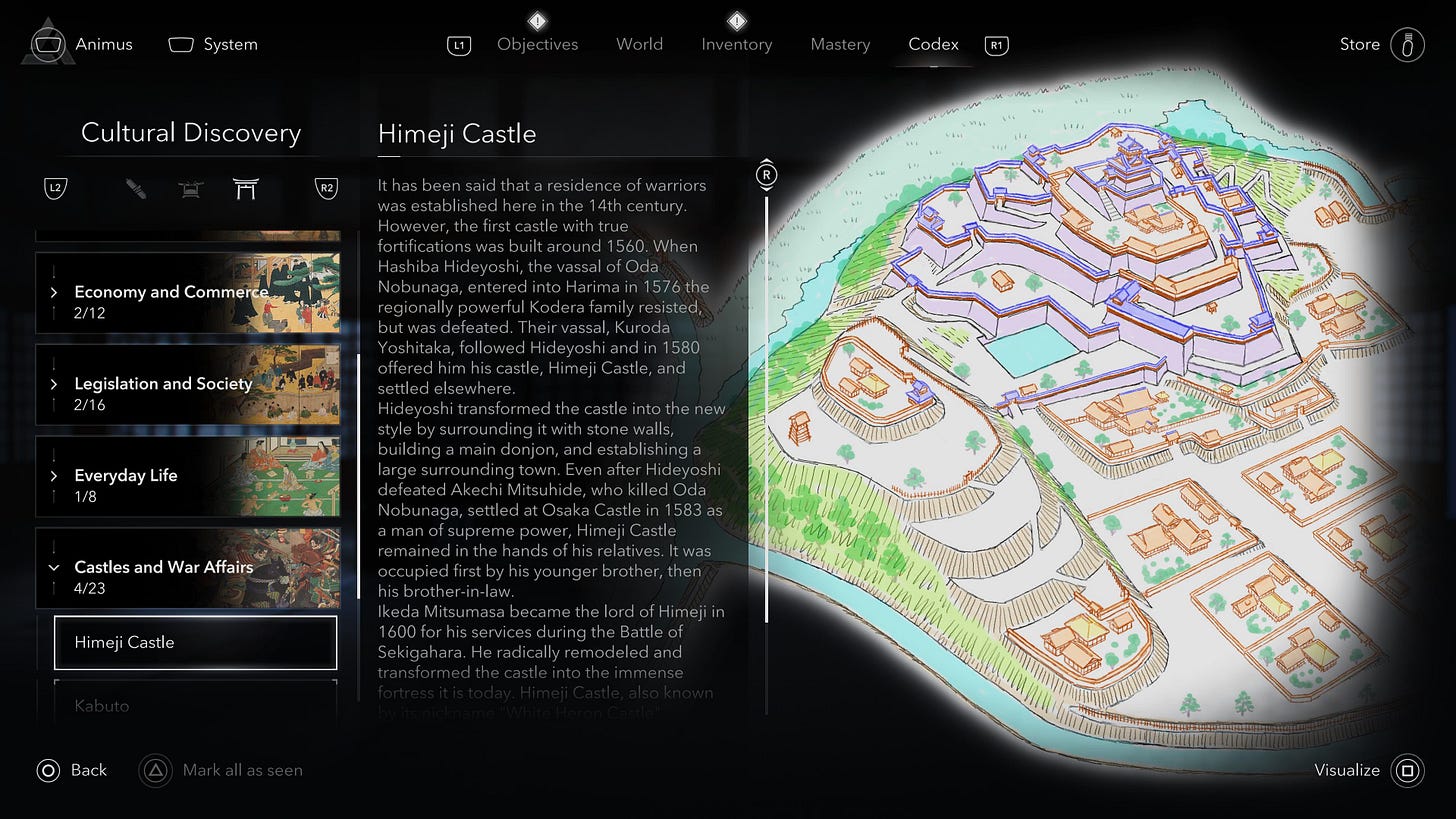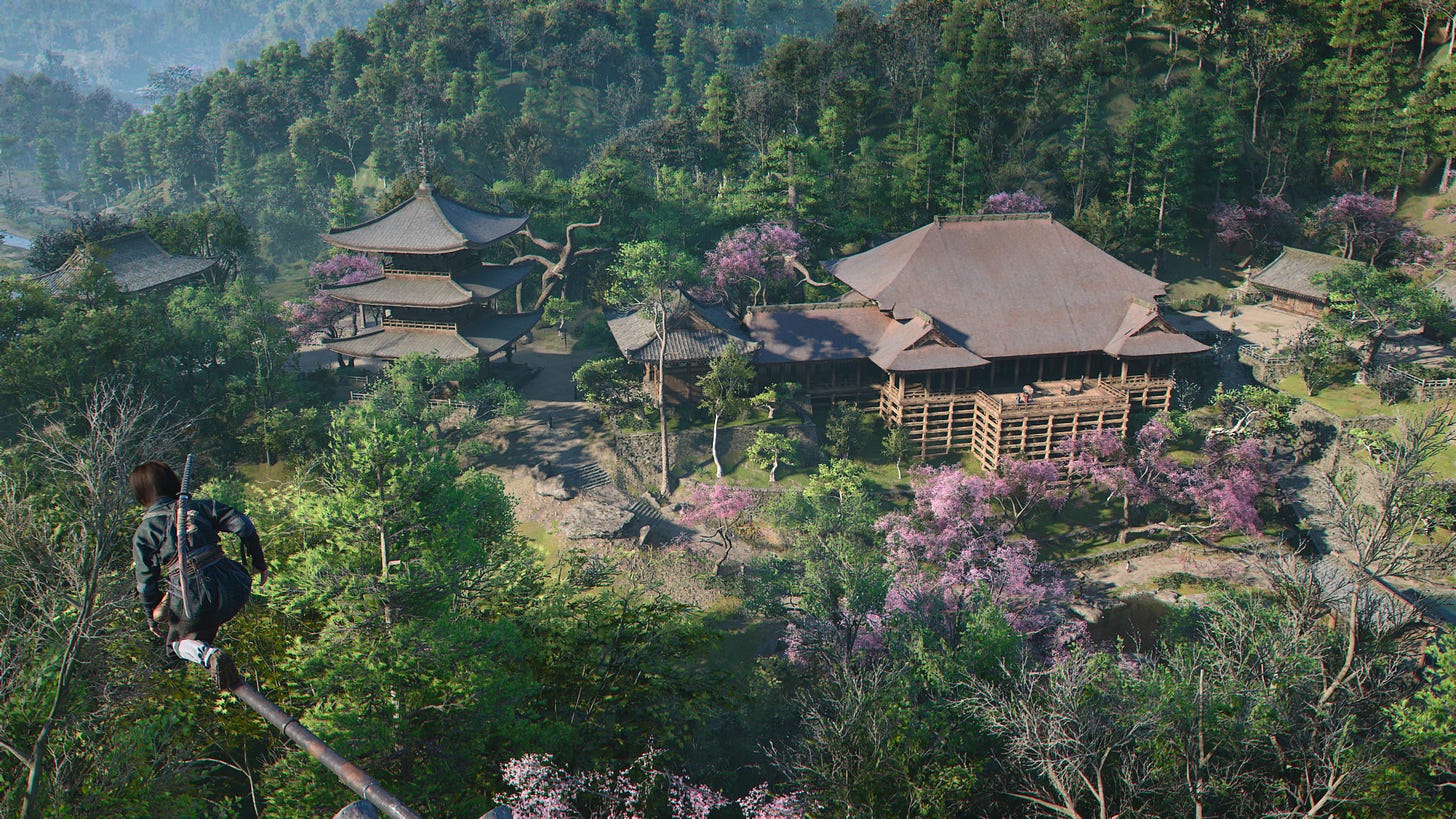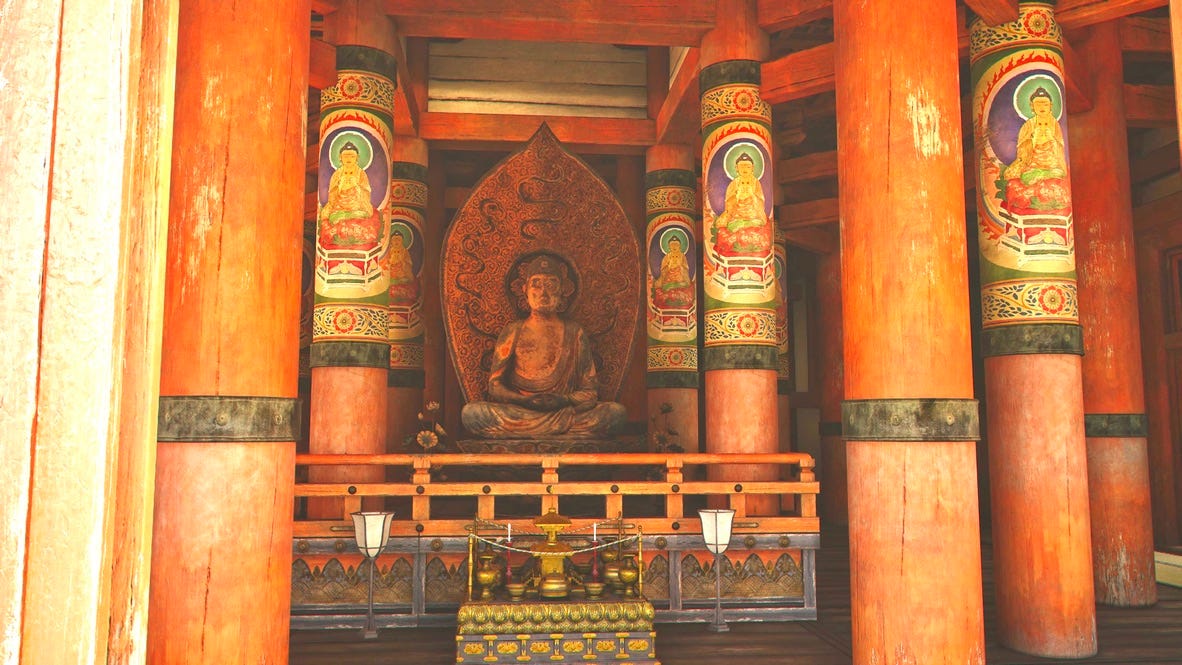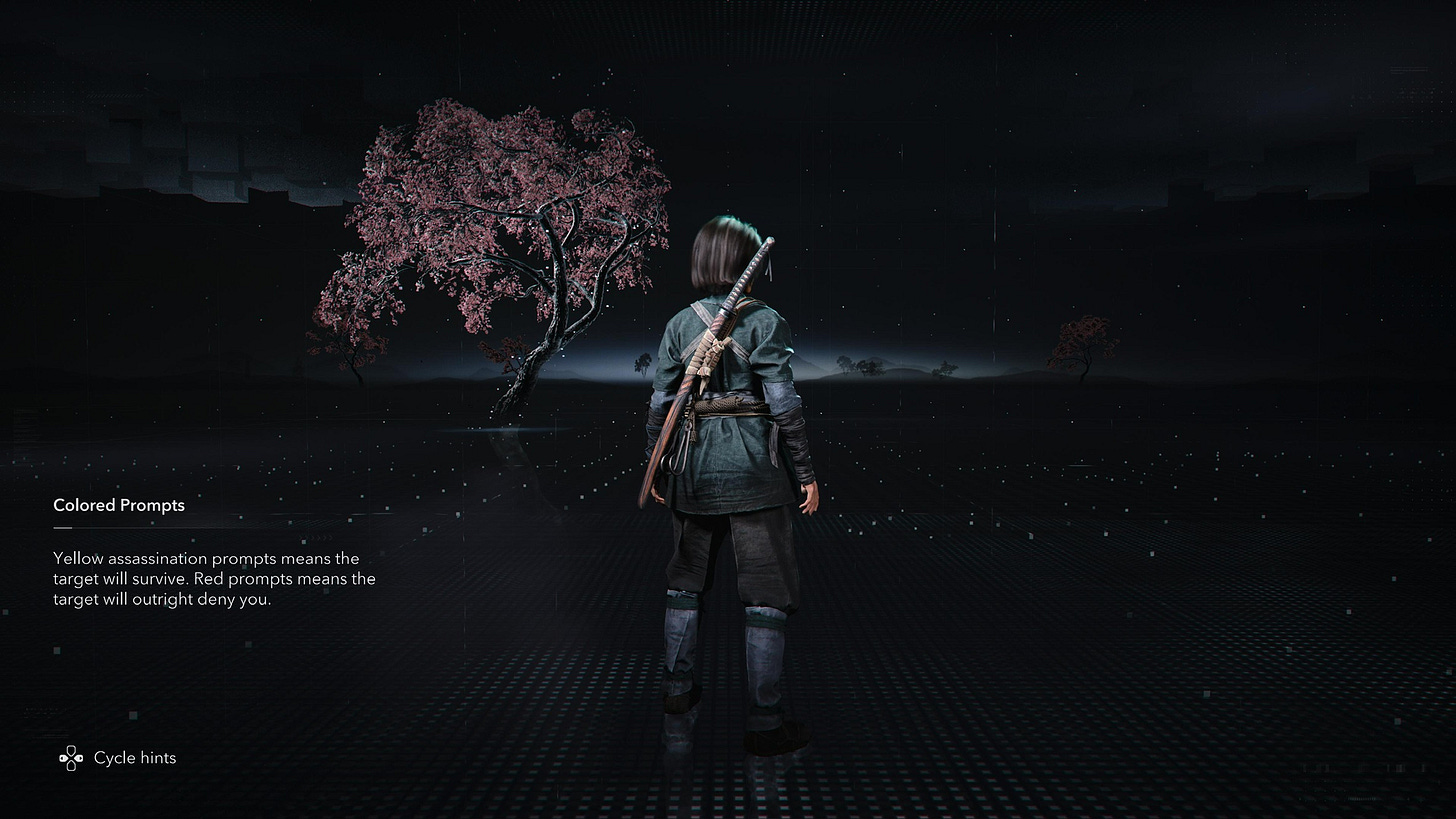Assassin's Creed: Shadows (PS5): A Religious Studies-focused Scholar's Honest Review
The good, the bad and the obviously missing...
A Note: Ubisoft UK were kind enough to provide me code on 7/3/2024, including the pre-order bonuses and access to the first DLC pack.
I didn’t sign any NDAs although I did agree to abide by their embargo date and time (18th March, 5pm GMT).
This review contains my honest feelings. I played as Naoe as much as possible and did so with the Japanese dialogue track,
Also, if anyone finds Fushimi Inari Taisha, Kitano Tenmangu and other ‘missing’ locations/shrines/temples, I will update this document.
I did ask Ubisoft UK for a list of included UNESCO World Heritage and other important sites before publication but got no reply ahead of the embargo lifting.
They did provide a shorter list of places to visit/activities as part of the Review Guide (which I am not allowed to publish) and I used this as a basis but found most of the places in my play through from personal knowledge of cities like Himeji, Kyoto, Osaka and Nara.
Japan has been the dream location for an Assassin’s Creed game for years now and so the news that we were finally getting to parkour around castles, explore ancient cities which still exist today and visit religious sites while roleplaying as a samurai and a shinobi was always going to be an exciting prospect.
As a Japanophile and academic with a Master’s degree in Japanese Studies, this game was something I’d been following since its announcement.
I have long ties with the franchise, having worked as a journalist back when the first game came out and there’s something about getting to play it at a preview event in a London church’s undercroft which sticks out as one of my favourite press events
I’ve also been to many of the locations featured in the game, especially the areas of Osaka, Kyoto, Nara and Himeji. One of my passions is virtual photography so I was excited to get some nice shots of these locations as well as hiking up Fushimi Inari Taisha’s Inari-san which I didn’t have the constitution to do in real life.
Given the various newsworthy issues and the change in release date: Assassin’s Creed: Shadows has been reworked in places.
This is no more obvious in the opening cut scene where Diogo—a very young African man in obscenely red clothing—meets Oda Nobunaga, only to reveal he knows Japanese. It’s not clear if this is some or fluent but this will be the start of his service to the daimyō. Elements of this scene have been reworked; the tatami is now the right shape, and everyone sits cross-legged as was the style of the time.
Great. Right?
I need to talk about this shade of red for a second as it’s obnoxious and bothers me. Diogo wears it in this initial scene, and it’s the game’s equivalent of a neon vest screaming: PROTAGONIST!!!
Japan has a long history with red, but the shade found in the religious world is coded vermillion, the kind which gets a patina with age and demarcates ritual spaces and religious apparel. Outside of that red is often seen as auspicious; it appears in the hinomaru, the Japanese flag, but Japan has a deep relationship with the colour and specific shades.
This scarlet is the game’s signature, with a range of in-game clothing and the Sekiryu mount (which we’ll get to in a second) feels like it will break the game’s otherwise good attempts at recreating Japan. The colour feels alien and is so bright my blind friend with two prosthetic eyes should be able to see it.
This lack of understanding of the importance of red and specific shades feel like shorthand for everything Ubisoft got confused about, from the specific cultural differences between Japan and China which people will get very touchy about like the whole boba tea collab (which is Taiwanese, not Japanese) to getting the types of dragons mixed up.
I’m not even sure what kind of dragon this … thing actually is. It definitely doesn’t feel like a Japanese dragon (itself usually associate with water) and is giving me Chinese vibes. Also that colour, again, is just in-your-face levels of obnoxious. I hate this shade passionately and definitely won’t be donning any of this set during my wanderings as either Naoe or Yasuke.
I admit I went into this game with very low expectations. I accept this game as historical fiction: I don’t think Yasake was a samurai or even important and Naoe is my headcanon main character. All I wanted, and intended to do, was explore open world, visit places I know from my own travels and spend hours taking in-game photographs using Photo Mode.
Naoe, however, is a dream to play; she’s fast, lithe and sneaky.
I like/prefer playing female characters and I honestly think DEI is a good thing (although there are exceptions to this, like Black Myth Wukong but I’ll get to that at a later point and another article).
She has the training to be a shinobi and, through meditation sequences, we see that she isn’t blessed. In fact, she works her butt off to become a shinobi. She earns her skills and pays for it in blood and sorrow.
From a mechanics standpoint, Naoe also has the ability to go prone (so does Yasuke but he is… chunky) and crawl around, she also has a grapple hook and can slide down steep hills which adds to the fluidity of her gameplay.
I love her design, her clothing options, her weapons; she even gets to wear amulets and other items which help with her stats, including a couple which are material omamori and wooden ofuda.
Also, she keeps adopting people, cats and dogs, which I approve of.
Yasuke is loyal to Nobunaga but he is also a tank, literally and figuratively. He runs into doors and rips people apart. This is so unrealistic that I actually didn’t want to play these sections.
Honestly, I seldom played as him except for mandatory missions and those points in the open world when he was needed to open doors into puzzle tombs.
His story—even with the kata flashbacks—lacks the depth, the realism of Naoe’s and while it’s obvious the devs reworked the story to focus less on him, he still exists and there are times where you have to play as Yasuke.
Also, because of having two protagonists, we get to see the fall of Iga and the same cut scenes several different times, with the same scenes repeating over and over again.
I honestly prefer Assassin’s Creed with a single protagonist (the Ezio games, Black Flag, Origins and Rogue being my personal favourites) and would have loved the option to choose gender and persona a la Skyrim or Soulsborne myself rather than being forced into not one but two characters.
I honestly think Naoe would have been a stellar, canon and stand-alone protagonist. We don’t need Yasuke but I suppose Ubisoft committed so now I have to suffer certain core parts of the game playing as him.
So what about the world?
The world of the game, which broadly covers the Kansai region of Honshū, Japan’s main island, is massive. The map itself covers the old prefectures of Tamba, Wakasa, Omi, Yamashiro. Iga, Harima, Settsu, Yamato and Kii.
I do like the sound design and the soundtrack, the score in particular, sounds good, as well as mixing elements of previous Assassin’s Creed themes. I’ve been listening to it on Spotify and it’s fine. The tracks flow nicely, have the right aesthetic but didn’t distract while I was exploring.
I really like the hidden elements of the game; I was exploring near Sakai and found my first kofun. These are keyhole-shaped burial mounds which exist in the real Japan and are things which fascinate real academics. But kofun are also sacred sites so when Naoe shimmies inside, it feels a tad… irrespectful.
What follows is a short, winding maze with juicy loot at the end. Naoe can use lamps to mark her passage a la Theseus and the ball of string. At the end, a false wall loops back to the opening and you leave.
There’s nothing down there but it’s an interesting diversion, having to navigate your way through twists and turns, using only your own footprints and light sources to figure out where you’ve already been.
I like the mechanics of this, it reminds me of the puzzle tombs in Tomb Raider, which also had a Japanese aesthetic as it was set on the lost island of Yamataikoku, where Lara had to defeat environmental puzzles to get loot. Except those spaces weren’t real and kofun are. Entering feels disrespectful and pilfering made-up loot feels wrong.
To give you an example, here’s a news article I came across while I was reviewing the game, which should give you an impression of how these sacred monuments are regarded in Japan. The scholars didn’t go inside it, they just went onto the site!
Note: Coincidentally, this is the same kofun that I explored in the game, right next to the port of Sakai.
Oh dear…
I hated the scout system; all it does is periodically (when the game feels like it and always at the start of a season) you can send out scouts to do some recon but all I got was ‘rumours say there is a shrine at x’ (marked with a ? that you had to then go and find). The seasonal system is great in theory, the contrast between the seasons is nice but it takes an age for them to rotate (and you can only change them manually every so often).
I did like the Hideout but it took me ages to find enough consumerables to build, especially as I needed the money to buy Fast Travel points outside from the Syncronisation points. Japan, in game, is big and the Fast Travel needs to be unlocked with cash, near major places, in cities or important sites.
The modern elements are gone from the game, although we do have a few nods to the larger lore of the franchise, such as the appearance of an etheral being called The Guide. She seems to be more detached than Juno and I wonder if she’s the apotheosed form of former future protagonist Layla Hassan, last seen in Valhalla, as The Reader was Desmond Miles.
The issue is do we judge Shadows as an Assassin’s Creed game or as a Japan Simulator (1579 Edition)? It works as the latter but people are here for the former, even if you removed all these elements we’re used to up until this point.
As a Japan Simulator (1579 Edition), Shadows works but after you’ve wandered the map, uncovered all the places (I uncovered perhaps 80% during my play through) and leap of faith-ed from a dozen very similar Japanese castles, like Himeji and Osaka, or climbed pagodas to get a better view (only some serve as Synchronisation points).
The verticality of the map is on point, with high mountains, lush valleys and I especially like the seasons-mechanic. But, outside of towns, cities, temples and shrines, there’s a heck of a lot of empty space. I could easily wander for hours (as I did looking for Fushimi Inari Taisha and Kitano Tenmangu shrines), following paths through wilderness, broken up by rivers and hills so steep Naoe couldn’t climb them.
I do love Naoe’s ability to observe and learn things about the in-game world which then explains aspects of real Japanese history. But the map is lonely, with very few points of interest, even if the Synchronisation points aren’t too far from each other, there are a disturbing lack of things to find and places to visit, marked by a ?, in the game world. Even if its filled with foxes and deer and other wildlife (which Naoe will observe and sketch if she can get close enough), as well as beautiful vistas which do a brilliant job capturing the Japanesque lighting that any visitor to the real country will understand.
The encyclopedia is especially interesting with six to seven hundred words on subjects like music in Japan to locations, landmarks and temples. This is obviously where academics have gotten involved to write on a plethora of subjects which educate and entertain. I like that it’s divided into sections and having to hunt for the right glowing focal points gives me something to hunt for beyond the locations themselves.
I also really liked how your characters can gain buffs and Knowledge from exploration, as well as sometimes leveling up if you explore long enough. There are also perks for exploring religious locations. Temples instruct you to find Hidden Pages while shrines give you points if you pray x/y times at each altar or worship hall within a complex.
It would have been nice if you could collect in-game seals (gōshuin) as you can at real Japanese temples and shrines, or purchase amulets (you can buy omamori which mix up your stats but not from shrines and temples). But nope, you can’t, and it feels like a missed opportunity. Both of these would have fitted in with the period and it feels like a missed opportunity to not get something more tangible from exploration and prayer, which feels into an actual things which people have been collection since the seventh century.
Yes, as per the infamous viral video, you can opt to destroy the shrines and temples’ interiors or you could, you know, just not. You can climb on temple walks, rooves and on some torii gates. I chose not to but I’d think once the area is refreshed then everything would be restored.
Respect, even in digital recreations of sacred spaces, costs nothing, folks.

I took Kiri, Naoe’s horse, and headed southeast into Kii and found myself in a familiar forest, climbing high into the mountains until I found a mon gate and the cue on screen told me we’d arrived at Koyasan. As someone who went there before it was cool in the real world, I can tell the devs did their research.
In fact, to me, the mountain feels like one of the most faithful digital portrayals with the Okun-in cemetery (the largest in Japan) and what is presumably Kobo Daishi’s mausoleum. It’s in the right spot but is, again, unmarked. The area also features a massive reconstruction of Kumano Hongu Taisha which feels like THE biggest shrine in the whole game.
Later, I headed north to Nara and Tōdaiji, the famous temple. The complex is huge and you can even see the herds of deer, although there are no senbei sellers or the ability to pet them. They just wander, quite non-agressively, around the park near the temple.
I had expected to be able to go inside and see the Daibutsu. The same cue announces you’re in the right place but the temple is shut and the doors don’t budge and it made me very sad.
The other thing is the generic nature of the locations. Some, like Kiyomizodera, are gorgeous with the famous gate, the pagoda and the beautiful stage of the main temple hanging off a mountainside. You can even see the sacred spring divided into three streams for pilgrims to chose if they want health, wealth or prosperity. You can even listen to monks reciting the entire Heart Sutra and watch the world change around you, looking down on Kyoto from the sakura of spring to the red leaves of autumn.
But when it comes to finding the temple’s statue to Kannon, there’s nothing.
All the buildings feel empty and even when they are open, some of them are just missing things.
As Kiyomizudera is a temple to Kannon, there should be a replica of its famous statue, just as Todaiji should have its Great Buddha but that temple is locked shut.
Ubisoft, if you’re going to include such important temples within a game, you should at least try to include important aspects of what are now UNESCO-level World Heritage sites.
The answer is obvious; they couldn't get the use from the copyright owners in the game.
Japan takes copyright very seriously, to the point where earlier in the development cycle various items appeared in concept art and earlier builds which the company didn’t have permission to use, such as the one-legged torii gate from Sannō Jinja in Nagasaki, a lantern and the banner of the Sekigahara Rifle Corps.
So they’ve obviously been unable to use the images of these important religious artefacts and so have been forced to either shut up the places we would expect to find them or leave them open and empty.
And it’s sad. Like putting in half the effort despite there being some truly beautiful examples of religious art in places.
These sites aside, there is an obvious cut-and-paste nature to the religious and other assets in the world. Almost all of the Shinto shrines follow the same layout with the same vermillion colouration. There are perhaps three different types of torii: stone, painted and ones with small rooves (which you can climb for some reason). Even important named temples like Iwashimizutaisha and Kamigamo Shrine are fundamentally copies of the same in-game template without the element which make them unique.
Many of the bridges, for example. are that same bright red, and oddly formal for the middle of nowhere when others are simple pieces of stone or wood across streams.
Various points in the map also use what I can only class as a ‘massively over-grown bonsai trees’ which Naoe can use to get to new Synchronisation points or to get inside castles (which have double moats and sort of unclimbable walls unless you know just the spot) which are huge and have strange yellow plinths nailed into them so you know you can climb them.
This is weird but when Yasuke tries to ‘stealth’ across them in full armour, it’s down right immersion-breaking.
Similarly, all of the pagodas look identical, even in their destruction at some sites and the same kinds of torii gates appear all over, sometimes normal-sized, other times over-sized as per some you can see in the real-world Kyoto, like the one near Heian Jingū. A couple in Kyoto don’t even mark a shrine and just sit there as if someone saw that particular torii and decided it looked so cool it needed to be in the game, despite there being reasons for it in the real world.
Kamigamo Jinja, for example, is a large shrine north of Kyoto which is known for its two piles of sacred sand, the tatesuna and saidan, which represent Mount Koyama and provide visiting kami with a holy place on which to settle. It also has an almost Buddhist aesthetic to certain parts of the temple. Neither of these are present.
Given the recent news stories about the shrine in Himeji and in-game digital destruction of an active religious site in Himeji, I wonder how many other religious institutions have either pulled permission behind the scenes or otherwise refused to allow important World Heritage sites and religious artefacts to appear in the game.
That would explain the generic feel to many of the named shrines and temples and it certainly sounds like a more appealing narrative than half-arsed research.
Despite searching for it, I couldn’t find Sanjusangedō or Fushimi Inari Taisha, both important religious locations which existed during the game’s timeframe. Kyoto is also missing many other smaller temples which have a long history within the city and are important sites for reasons other than being familiar to tourists.
It is also worth mentioning that locations do sometimes move. Within the game, the location of Honnōji Temple is an Oda stronghold which has an important role in a specific episode of the game, something Ubisoft asked us not to speak about. However three seconds on Wikipedia will confirm what this event was so go ahead, I’ll wait. Gotta love the historical record.
Anyway, the temple was eventually burned down and when it was rebuilt, due to the above event, it was moved to a new location nearby. This is something seen in Shinto too, with the Inner Shrine at Ise being rebuilt every twenty years in a new location a few metres away from its current site.

Assassin’s Creed Origins and Odyssey feature the series’ biggest maps but they had four years and three years between them. Shadows also, reportedly, had four years but it also has its release date changed multiple times and a period of obviously rushed story rewrites after the backlash around Yasuke.
In Kyoto itself, is a shrine which much be Seimei Jinja due to its location but there is no confirmation in game, despite it being north of the city and a few blocks over from Nijō Castle. But there is no peach or sacred tree, or even Abe no Seimei’s pentagram to mark the place as somewhere different than the city’s other shrines.
The games industry veteran in me understands why such places were either cut and pasted or missed out entirely. Japan is a huge country and even the area featured, added in the sheer verticality of Japan, in the game is massive. Yet, if you decide to set a game in Japan, you should be prepared to work exceptionally hard re-creating places that locals and tourists alike will expect to see.
Ghost of Tsushima used the landmass as a suggestion, rather than a 1:1 historical recreation of actual places, castles, temples and shrines. The developers also added in locations which paid homage to some of the great pieces of religious art found in Japan (a list can be found in the glossary of my paper on Ghost of Tsushima).
Rise of the Rōnin, similarly, decided to split the game into closed-off game worlds focusing on Yokohama, Edo (modern day Tokyo) and Kyoto. You cannot ride from Yokohama to Kyoto and each city and its environments also correspond to a timeframe within the narrative. This is actually similar to what the original Assassin’s Creed did with its three main cities, each of which was kept in its own bubble due to memory or graphical constraints.
The Assassin’s Creed elements feel forced and shoed in. Naoe is given her hidden blade as it’s a key to find a treasure her family protects, only to find a wall with the series logo on it. Then she begins her quest to find thirteen masked people which feels lifted out of Origins but with a Japanese skin overlayed on the mission.
I really liked the new season-shift mechanic, even though there were some places which still had sakura in the wrong time. Similarly, I wanted to be able to change the time of day for maximum in-game photography only to find that’s been removed wholesale and there isn’t even an option in photo mode either.
Honestly, the main narrative didn’t compel me much, although I liked the ability to make my hideout and recruit real-world inhabitants as scouts or helpers — at least until I understood the mechanics of it. I did enjoy being able to pet all of the animals, from lazy cats to rather large Akita or Shiba dogs and finding animals to draw and places to meditate.
If all you want to do, like me, is explore Japan and take photos then this is perfect.
If you’re an academic you might have a headache by the time you’re done, especially with the other Japan simulators on the marketplace and Ghost of Yōtei coming later this year (which I’m REALLY excited for). If you’ve been with Assassin’s Creed for two decades, then you might be wondering where the 21st-century timeline has gone, I did but I couldn’t be bothered to find or follow what remains of it
The game, ultimately, looks gorgeous but it’s a single layer of paint which scratches off far too easily. Shadows, ultimately, feels like a rushed addition to the series which will annoy far more people than it will gain players. It’s got too much controversy attached thanks to the various issues in its development history and will no doubt irritate the very people of the country it’s set in.
As for the rest of it, only time and a day one patch, will see if the game becomes a beloved entry in the franchise or if there is too much infamy associated with it to have a long life. I’m especially keen to read the Japanese reviews as I am painfully aware of my gaikokujin status, especially as an academic, even one who has spent over twenty-five years in love with Japan and its culture.
Honestly, I’m still surprised we even got here, given the issues.
I fully expected Shadows to never be officially released in Japan due to the backlash.
Obviously, as you’re reading this before the launch, this is something we’ve yet to see but March 20th is going to be interesting (already a date of dread for Tokyo as it’s the 30th anniversary of the Aum Shinrikyu Sarin attacks).
Obviously, once the embargo drops, I’m going to be very interested in what everyone else thinks of the game (it’s been a very pre-internet experience in terms of not having a network of journalists to discuss it with).
These remain my thoughts as a scholar, an academic with a literal Master’s degree in Japanese Studies and a quiet veteran of the gaming industry. I hope that Ubisoft learn from this cycle of chaos and controversy, I hope other devs do too, in order to create better Japan-focused titles, especially in the historical and cultural spaces.
For now, there’s still more game map to explore, more cats to pet, more shrines to pray at and an awful lot of beautiful photos to take.
Let me know what you think of the game below!

